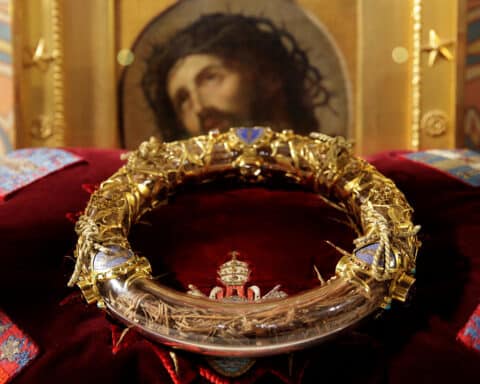In a side chapel of the Basilica of St. Praxedes in Rome sits a fragment of black and white stone. It is claimed to be the Column of Flagellation, a piece of the pillar at which Jesus was scourged, brought back to Rome by St. Helena.
However, in Jerusalem is a near-identical story. In a side niche in the Chapel of the Apparition in the Church of the Holy Sepulchre, stands the portion of a pillar, this one made of red porphyry, also claiming to be the Column of Flagellation.

It is highly unlikely that they are both fragments of the same pillar, considering their differences in material and size. Does this mean that one church is in possession of the column of Jesus’ scourging and one is not? Or perhaps neither of these are the sacred pillar from the Passion.
If so, why are these on display if their authenticity hasn’t been verified? Should we venerate objects we aren’t certain about?
The answer may come as a surprise: it doesn’t really matter.
Honoring the cross
On Good Friday, priests and deacons in parishes around the world will hold up a cross, declaring, “Behold, the wood of the Cross on which hung the Savior of the world. Come, let us adore!”
Of course, the crucifix in your local parish likely doesn’t contain the wood of the True Cross. It’s not the very same instrument that St. Thomas Aquinas describes in the Summa Theologica as “being saturated with His blood.” Yet we are called to come forward and venerate it with a profound genuflection.
The Second Council of Nicaea makes this strong declaration regarding images of Jesus and his Cross: “For the honor which is paid to the image passes on to that which the image represents, and he who reveres the image reveres in it the subject represented.”
Christ embraced his salvific mission fully and even literally. “By reason of the contact of Christ’s limbs we worship not only the cross, but all that belongs to Christ,” according to St. Thomas Aquinas (Summa Theologica, Question 25, Article 4. The embrace of Christ and his Cross is a mystery so deep and sacred that the Church declares that even mere representations are worthy of honor.
Venerating Christ
Neither pillar in Rome or Jerusalem may not be the exact pillar of Christ’s scourging, but their presence are tangible witnesses to what Christ endured for us. We are body/soul composites, and we need material things to help raise our minds to “what is above” (Col 3:2). We may not have been witnesses of Jesus’ scourging, but we can view these relics and spiritually visit Christ as he suffers. We cannot go and kiss Our Lord’s feet while he hangs upon the cross, but we are able to kiss or genuflect before a symbol of that event, knowing the gesture carries our love straight to Jesus himself.

In sum, we certainly should make a concerted effort to authenticate relics when we can. But the Church in her motherly wisdom understands that the ability to contemplate more deeply into Christ’s passion is far more important. Objects like the pillar of Jesus’ scourging, the crown of thorns, the lance which tore open his side, make Jesus’ sacrifice over 2,000 years ago present to us today. The visual reminders help us to imagine what those events were like, and how much Jesus suffered for you and me. When we venerate these objects, we still venerate him.
So when you come across a relic claiming to be from the time of Christ, don’t dwell too much on the question of “is this really it?” (It may very well be, even if we don’t know for sure.) Instead, let us remember he who really did suffer for us, who invites us to participate in his passion each day and who is always worthy of our adoration.





